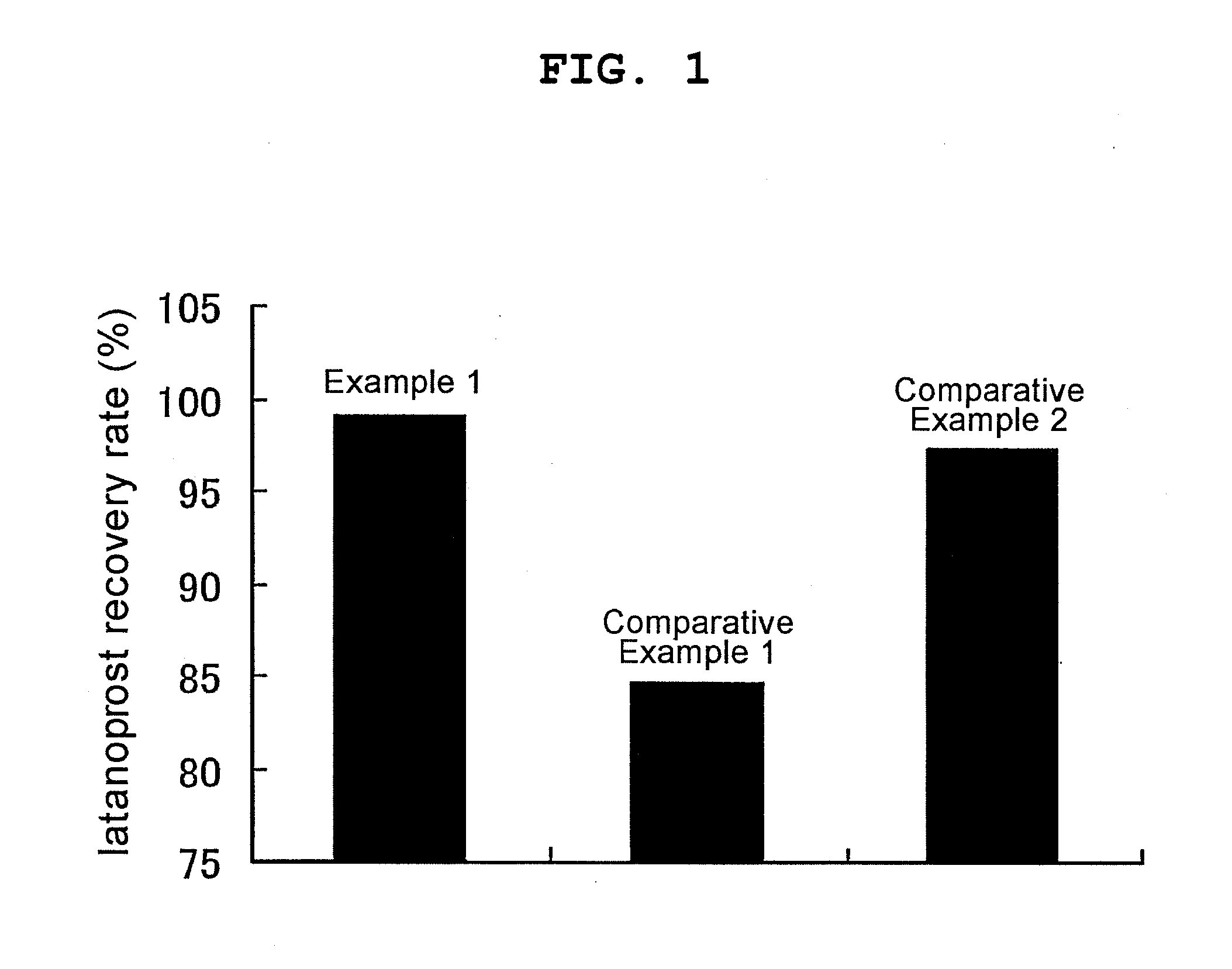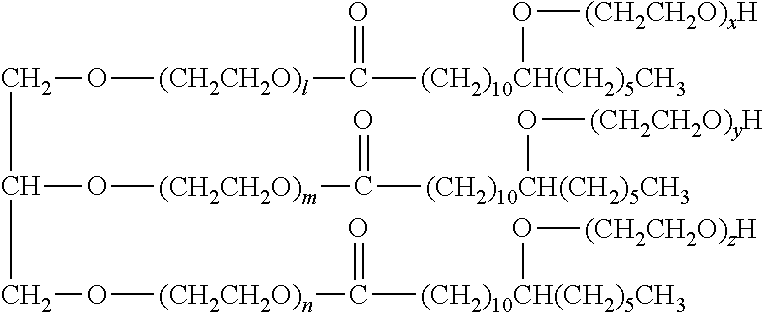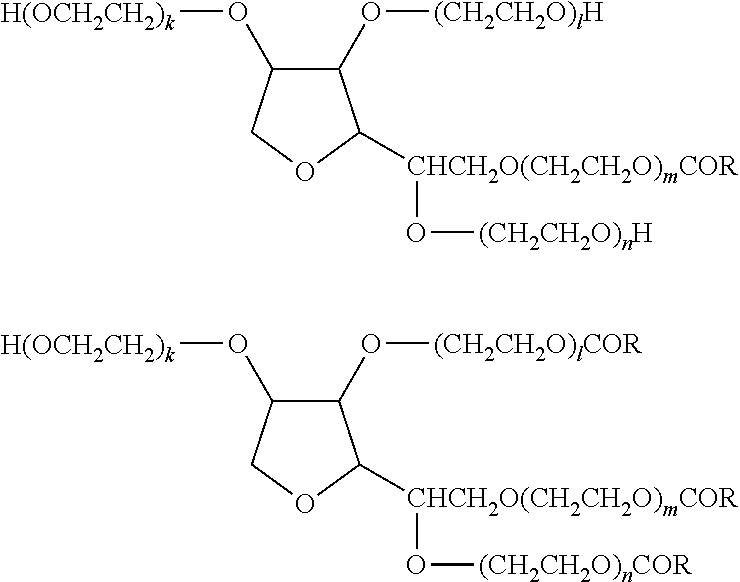Latanoprost-containing aqueous eye drops and method for inhibiting adsorption of latanoprost to resin
a technology of latanoprost and eye drops, which is applied in the direction of biocide, oil/fat/waxes non-active ingredients, drug compositions, etc., can solve the problems of reducing the effective concentration of latanoprost in the eye drop, affecting the stability of latanoprost, and requiring cold storage of the eye drop, so as to achieve the effect of suppressing the adsorption of latanopros
- Summary
- Abstract
- Description
- Claims
- Application Information
AI Technical Summary
Benefits of technology
Problems solved by technology
Method used
Image
Examples
example 1
Aqueous Eye Drop
[0089]The formulation of the aqueous eye drop of Example 1 is shown in Table 1 together with the formulations of the aqueous eye drops of Comparative Examples 1 and 2. For the preparation thereof, firstly, (1) in Table 1 was added to (8) (10% benzalkonium chloride solution), and the mixture was dissolved by stirring at about 50° C. to give a latanoprost stock solution. (2)-(7) and an appropriate amount of (11) were placed in a different container, and the mixture was dissolved by stirring to give a base stock solution. The entire amount of the base stock solution was added to the latanoprost stock solution, and the mixture was thoroughly stirred. (9) and (10) were added to adjust the mixture to pH 6.7, and (11) was added to the total amount of 1 L.
TABLE 1content (w / v %)ComparativeComparativecomponent Example 1Example 1Example 2(1)latanoprost0.0050.0050.005(2)tyloxapol0.06—0.06(3)timolol maleate0.68——(4)potassium sorbate0.47——(5)sodium chloride0.460.750.75(6)sodium di...
experimental example 1
[0090]Each 50 mL of the aqueous eye drops prepared in Example 1 and Comparative Examples 1 and 2 was filtered through a poly(vinylidene fluoride) resin membrane (Durapore membrane filter GVWP04700, manufactured by Nihon Millipore K.K.). The amount of the latanoprost contained in the filtrate was quantified, and a recovery rate (%) relative to the content of latanoprost in each aqueous eye drop before filtration as 100% was calculated. The results are shown in FIG. 1. Latanoprost was quantified by high performance liquid chromatography (HPLC) under the following HPLC measurement condition I.
[0091]Measurement sample preparation: Each latanoprost eye solution (2 ml) was precisely measured, dilution 1 (pH 2.0 trifluoroacetic acid solution / acetonitrile (1:2)) was added to make the total precisely 5 mL and the mixture was used as a sample solution. Separately, a latanoprost standard product (about 0.1 g) was precisely measured, dissolved by adding acetonitrile to make the total precisely ...
experimental example 2
[0096]Each 5 mL of the aqueous eye drops of Example 1 and Comparative Examples 1 and 2 was filled in two glass ampoules (DAIWA SPECIAL GLASS Co., Ltd., 5 mL colorless powder glass ampoule) and two polyethylene containers (manufactured by Hanshin Chemical Industry Co., Ltd.) obtained by blow-molding low density polyethylene, and they were used as samples. Each sample was preserved at 40° C. and 60° C. for 2 weeks, latanoprost was quantified by HPLC(HPLC measurement condition I) in the same manner as in the above-mentioned Experimental Example 1, and the ratio (%) relative to the content of each aqueous eye drop before preservation was calculated and is shown in Table 3.
TABLE 3Latanoprost content (%)*preservation conditionsComparativeComparativecontainertemperatureExample 1Example 1Example 2glass ampoule40° C.98.696.797.960° C.96.893.694.4polyethylene40° C.97.794.196.6container60° C.92.787.690.4*ratio (%) relative to latanoprost content of each aqueous eye drop before preservation
[009...
PUM
| Property | Measurement | Unit |
|---|---|---|
| carbon number | aaaaa | aaaaa |
| carbon number | aaaaa | aaaaa |
| aqueous | aaaaa | aaaaa |
Abstract
Description
Claims
Application Information
 Login to View More
Login to View More - R&D
- Intellectual Property
- Life Sciences
- Materials
- Tech Scout
- Unparalleled Data Quality
- Higher Quality Content
- 60% Fewer Hallucinations
Browse by: Latest US Patents, China's latest patents, Technical Efficacy Thesaurus, Application Domain, Technology Topic, Popular Technical Reports.
© 2025 PatSnap. All rights reserved.Legal|Privacy policy|Modern Slavery Act Transparency Statement|Sitemap|About US| Contact US: help@patsnap.com



